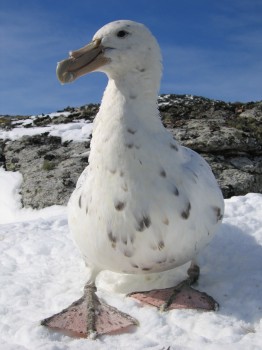Analía Garnero (Universidade Federal do Pampa, Campus São Gabriel, Brazil) and colleagues have written on chromosomal characterization of Southern Giant Petrels Macronectes giganteus and of three other procellariiform seabirds in the free-access journal Marine Ornithology.
The paper’s abstract follows
“The karyotype and C-banding patterns of Southern Giant Petrels Macronectes giganteus, Cape Petrels Daption capense, Black-bellied Storm Petrels Fregetta tropica and Wilson’s Storm Petrels Oceanites oceanicus were analyzed. To obtain metaphases, the direct culture technique was used on feather bulbs and lymphocytes of peripheral blood of 34 specimens. Both Southern Giant and Cape Petrels share 2n = 80 chromosomes. Pair 1 is metacentric; pairs 2 and 4 are submetacentric; pairs 3, 5, 6 and 7 are acrocentric; and the remaining ones are telocentric. The Z chromosome is submetacentric, and the W is submetacentric in Southern Giant Petrels and metacentric in Cape Petrels. In Black-bellied Storm Petrels (2n = 74), pair 1 is metacentric; pair 3 is submetacentric; pairs 2, 4, 5 and 6 and the remaining ones are telocentric; while the Z is submetacentric, and the W is telocentric. In Wilson’s Storm Petrels (2n = 70), pairs 1 and 3 are metacentric; pair 2 is acrocentric; and pairs 4, 5 and 6 are submetacentric; all remaining ones are telocentric. The Z chromosome is metacentric, and the W is submetacentric. All chromosomes except the Z chromosome of Black-bellied Storm Petrels revealed centromeric heterochromatin. The W chromosomes of all species were heterochromatic. We observed a numerical and morphological chromosome homology between the Southern Giant Petrels and the Cape Petrels, but very different phenotypes, while Black-bellied and Wilson’s Storm Petrels are phenotypically similar, but their karyotypes differ in chromosome number and morphology.”

A Southern Giant Petrel in Antarctica. Photograph by Michael Dunn
Reference:
Garnero, A. Del V., Boccelli, M., Oliveira, J.C.P., Ledesma, M.A., Montalti, D., Coria, N. & Gunski R.J. 2013. Chromosomal characterization of four Antarctic Procellariiformes. Marine Ornithology 41: 63-68.
John Cooper, ACAP Information Officer, 26 July 2013

 English
English  Français
Français  Español
Español